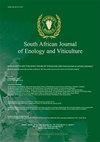Influences of Berry Size on Fruit Composition and Wine Quality of Vitis vinifera L. cv. ‘Cabernet Sauvignon’ Grapes
IF 1.1
4区 农林科学
Q4 FOOD SCIENCE & TECHNOLOGY
引用次数: 19
Abstract
The heterogeneity of berry heterogeneity is a commonly occurring phenomenon that has a big influence on fruit composition and wine quality. To clarify this relationship, ‘Cabernet Sauvignon’ grapes were collected at harvest from a single vineyard and divided into three categories in two consecutive years: small (≤ 0.75 g), medium (0.76-1.25 g), and large (> 1.25 g). The medium berries were present in the highest frequency, accounting for more than 50% of the berry populations. The standard physicochemical parameters of the fruit were significantly affected by berry size. The relative skin mass and soluble solids contents, as well as total phenolic and anthocyanin concentrations, decreased with the berry size, while the relative seed mass, pH and malic acid content were positively correlated with berry weight. Accordingly, the wine composition also varied with berry size, as the wines made from small berries showed the highest alcohol and residual sugar content. CIELab parameters of the resulting wines showed the small berries were more desirable for making wine with a deeper and more saturated colour. With regard to volatile compounds, berry size showed a limited effect. Only 1-hexanol and laevo-2,3-butanediol showed consistent and significant trends across vintages for wine volatiles, which showed the highest levels in wines made from the small category of berries.浆果大小对葡萄果实成分及酒品质的影响。赤霞珠葡萄
浆果异质性是一种常见的现象,对果实成分和葡萄酒品质有很大影响。为了阐明这种关系,“赤霞珠”葡萄在收获时从一个葡萄园采集,并在连续两年内分为三类:小(≤0.75克)、中(0.76-1.25克)和大(>1.25克)。中等浆果的出现频率最高,占浆果种群的50%以上。果实的标准理化参数受浆果大小的显著影响。相对果皮质量和可溶性固形物含量以及总酚和花青素浓度随浆果大小而降低,而相对种子质量、pH和苹果酸含量与浆果重量呈正相关。因此,葡萄酒的成分也随着浆果的大小而变化,因为由小浆果制成的葡萄酒显示出最高的酒精和残留糖含量。CIELab对所得葡萄酒的参数显示,小浆果更适合酿造颜色更深、更饱和的葡萄酒。关于挥发性化合物,浆果大小显示出有限的影响。只有1-己醇和左旋-2,3-丁二醇在不同年份的葡萄酒挥发物中表现出一致和显著的趋势,这在由小类浆果制成的葡萄酒中表现出最高的水平。
本文章由计算机程序翻译,如有差异,请以英文原文为准。
求助全文
约1分钟内获得全文
求助全文
来源期刊
CiteScore
2.50
自引率
7.70%
发文量
1
审稿时长
>36 weeks
期刊介绍:
The South African Journal of Enology and Viticulture (SAJEV) publishes full-length original Research Papers, Research Notes and Review Papers on all subjects related to enology and viticulture. The SAJEV does not accept articles published in, or submitted to, other journals.

 求助内容:
求助内容: 应助结果提醒方式:
应助结果提醒方式:


